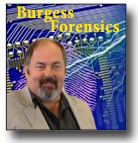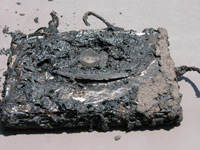 This event featured a presentation by forensic data expert Steve Burgess, who "edutained" us with his fascinating "CSI-type" stories and practical how-to tips on protecting your data, recovering it if it becomes damaged, and dealing with the legal implications of data searches.
This event featured a presentation by forensic data expert Steve Burgess, who "edutained" us with his fascinating "CSI-type" stories and practical how-to tips on protecting your data, recovering it if it becomes damaged, and dealing with the legal implications of data searches.
Nothing is as instructive as hearing lessons learned the hard way from real-life case studies. Steve shared plenty of illuminating stories from his own extensive practice at Burgess Forensics.
Litigation is a major area of Steve's consulting work, as he explains on his Web site: "State and Federal law have been evolving to allow and require ever-more forms of electronic data to be available for e-discovery when litigation is involved. Now discoverable data may be on hard drives, servers, thumb and flash drives, smart phones, voice mail and data in its myriad forms."
Steve covered the following important ways of working with your data to make sure it is safe, accessible, and recoverable:
1) Data Protection — preventative safeguards you should have in place to keep data secure
- Creating an optimal physical environment for your computing equipment
- Techniques and timetables for backing up your important information
- The effect of heat and power issues on the viability of your data
2) Data Recovery — steps you can take if you happen to lose information because of accidents or errors
- Tips regarding whether, when, and how to try restoring data yourself
- When you should call an expert, what to look for when you do
3) Legal Implications — how data can persist forever, and what it means from a legal standpoint
- Traceable data trails that you or others can generate without even realizing it
- What lawyers and law enforcement officers are allowed to look for on digital media
- The implications of data searches for employers and employees
Read Steve's data safety and recovery tips, below, and download this handout as well as his PowerPoint presentation, linked further down.
Data Safety: Being Proactive
Set up your computer workspace for success, so you won't need data recovery services.
1. Heat: Many hard disk failures are due to heat.
- This may come from the environment, from two drives being too close together, or from an overworked system fan in an overpowered system.
- Keep PCs out of the sun, and keep them in a temperate room.
 Don't put a computer on a soft surface, such as on carpeting. This keeps air from circulating and may plug up vent holes.
Don't put a computer on a soft surface, such as on carpeting. This keeps air from circulating and may plug up vent holes.
- If you add an extra internal hard disk, try to leave a bit of airflow space between hard disks inside the computer.
- Auxiliary fans (such as those that fit in disk drive slots) are useful, but make sure the airflow assists the main system fan, rather than working against it.
2. Cold: Extreme cold may cause failures as well.
Dust and fur: Dust makes heat problems worse, ruins cooling fans, can gum up moving parts (like fans, or CD or floppy drives). Cats love to sit on nice warm computers and monitors, but pet fur will coat the components inside your computer like a custom kitty- or doggie-fur sweater.
3. Vibration: Is a great enemy of hard disks.
We often see systems sitting on the floor, in easy reach of tapping feet, and full of dust. Impact and inkjet printers sitting too close, or on the same table, can cause too much vibration over time, as can subwoofers. Systems on slamming file cabinets are a bad idea, too.
4. Electrical: A tremendous number of drive failures are related to power surges.
Fluctuations happen all day, every day in nearly every environment. Economy power strips are not much of a solution. Uninterruptible power supplies are a practical solution, as they isolate the system from the wall current.
Taking Safety Measures:
Actions a User Can Take to Make Computing Safer
1. Backup: If everyone backed up all of the time, no one would ever need data recovery. But no one backs up all of the time and most don't ever back up at all. An excellent method of backup is an external hard disk.
2. Turn off at night: There are many schools of thought on this subject, but here's our view from two decades of data recovery. Turn off the computer at night and it won't be subject to the vagaries of the environment, hackers, power surges, or the occasional earthquake or flood.
3. Save: Hit the Save button frequently while working on a file or document. All too often, the crash happens at the end of a couple of hours of heavy thinking and rapid writing. Get in the habit of saving every time you stop to think.
Emergency! The Computer Has Failed: What Now?
1. Impact: Turn everything off for 5 minutes and let things stabilize. Once everything is turned back on, check files and applications for damage. Make sure there's a backup of the important files right away. Be alert for errors indicating deeper problems.
2. Power surge: Unplug everything and let it sit for 15 minutes. Then, as above, bring the system up & check for damage. Proceed with caution.
3. Water or fire: Unplug everything. Put the hard disk in a sealed plastic bag ("zip-lock" style bags are fine) and send to us for recovery. Don't dust out or try to dry out. When dried, water can leave mineral deposits or other contaminants behind, as can smoke.
4. Symptoms:
- Screeching or scraping. This is a bad sign. Immediately turn off the computer. Let the hard disk stabilize for a few minutes and either remove the hard disk or unplug the power from it. Then turn the computer back on. If it's still screeching (and there's no power to the hard disk), the problem is not the hard disk. You're in luck! Your data may still be safe and you should have your computer diagnosed.
- Screeching or scraping, part 2. If the noise is coming from the hard disk, it has a serious problem and needs serious help. It is best to NOT turn the hard disk back on in this situation. It can take from only a few seconds to a few minutes to render the media unrecoverable when the noise is from a head crash. You need hard disk recovery. Call us for a quote.
- Clicking: As above, turn off the system immediately and determine if the noise is coming from the computer or the hard drive. A clicking sound often indicates head or media damage, and the longer the drive continues to spin, the deeper the damage will go. If your hard disk is clicking, don't try to restart the system. Call us for a quote.
- System won't boot, but there are no odd noises. Note — listen carefully for clicking sounds (see "clicking" above). Try booting into Safe Mode (on a Windows system), or with Extensions disabled (on a Macintosh) then see if the directory structure is accessible. If it is, you may be able to back up important documents to a floppy disk or an attached external hard disk.
1. Booting in Windows Safe Mode: When you power on your computer, press and hold the "F8" key right when you see the text. A text screen should come up that allows you several modes for starting. You want Safe Mode. Many systems have a corporate banner that hides the "Starting Windows... " text. Usually pressing the "Esc" key before the banner comes up will cause it to go away. Then press the F8 key.
2. Booting a Mac in safe Mode or with the Extensions off: Simply hold the Shift key when you start the Mac. This should cause OS X to boot into Safe Mode, where it will want to run First Aid. This causes OS 9 to boot with Extensions off.
3. Try booting from a floppy diskette, CD, or external hard disk: Be careful!!! Many systems come with a System Restore CD that will likely erase all of your data! Many times, a client has called after their computer vendor had them do this. Be careful! Even if someone tells you to do it, be aware that you may be erasing your data. Read all messages carefully. You want only to boot the system so you can back up files — you do not want to do anything that will write data or do any partition or format operations.
4. Try putting the drive in another system. Take the drive out of the computer, and put it in as a secondary drive in another system. You will need to change jumper settings, and if it's a laptop drive, you will need to get an adapter to plug it into a desktop computer. But you may be able to bring the drive up as a secondary drive in another system and copy your files off, or back them up. Again, take care to listen for any unusual sounds. If the drive begins to click or screech, you should shut it off immediately and call us for a quote to recover your data.
Copyright 2008 Steve Burgess